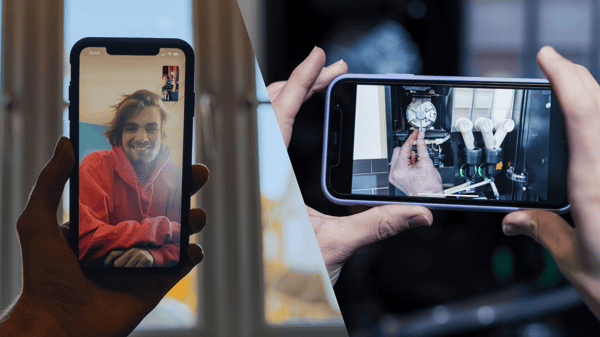Choosing the right remote support software is about more than just a list of features. It’s about how quickly you can solve a customer's problem, how clearly you can guide a technician in the field, and how well the tool fits into your company's unique workflow and budget.
Which remote support tool is best for your business?
The choice isn't about which platform is "better," but which one is the right tool for you. Below is an executive summary comparing XMReality and HelpLightning.
Choose XMReality if:
- You need a tool that is incredibly easy and fast for both your team and your customers to use, with no downloads or sign-ups required for your customers.
- You operate in areas with unreliable internet, as the video technology is optimized to maintain clear visual detail even on poor connections.
- You want the flexibility to build your own workflows using point-and-click integration tools.
- You're a small or medium sized business, or a specific department within a larger organisation, that needs a predictable, affordable, and scalable pricing model.
Choose Help Lightning if:
- You are looking for a platform to be a cornerstone of a major digital transformation initiative.
- You require deep integration with core company systems, and use one that is already supported by Help Lightning (e.g. ServiceNow, Salesforce).
- You have a significant budget for a strategic, multi-year partnership that includes software, consulting, and advanced analytics.
By understanding their core philosophies and key differences, you can confidently choose the remote assistance platform that best aligns with your organization's goals, budget, and vision for the future of service.
| Capability | XMReality | Helplightning | Comparison/winner |
| 1. Best for |
Quick, flexible support for teams and customers. |
Large-scale, company-wide service transformation. |
Depending on you business |
| 2. Easy connectivity |
Customers join via text message or WhatsApp. Smart glasses support. Use your own brand. |
Customers join via text message. Smart glasses support. |
XMReality |
| 3. Visual quality |
Adaptive video, works on low-bandwidth connections, perfect quality video freeze. |
Fixed quality levels with limited adaptation. Higher data usage (~5MB/min) |
XMReality |
| 4. Collaboration |
Hands overlay, point, annotate, remote zoom, image and screen share |
Merged reality AR gestures, annotate, image and screen share |
Tie |
| 5. Documentation |
AI transcripts and summaries, one-click PDF reports, video recording, still image snapshots, both local and cloud storage |
AI transcription and translation, automated tagging and smart folders |
Tie |
| 6. Integrations |
Ready-made for Salesforce, and Microsoft Office. No-code custom integrations, software developer custom integrations (REST API, webhooks), manual ticket number linking |
Ready-made for ServiceNow, Salesforce, Genesys. Software developer custom integrations (REST API) |
Depending on your business |
| 7. Pricing and scalability |
Starts at $35/user/month, scales with your team. |
Custom contracts with high minimums (e.g., ~$75k/year). |
XMReality |
| 8. Free trial availability | Yes | No | XMReality |
An in-depth comparison between XMReality and Helplightning
XMReality and Help Lightning are both leaders in the remote support market, but they are built for very different needs. Here’s in-depth side-by-side comparison of all important aspects when choosing your remote support software.
1. The Big Picture Comparison
Let's start by comparing these two platforms by looking at their origins.
XMReality
Powerful, Not Complicated. XMReality was born from high-stakes defense research, where the goal was to help experts remotely defuse landmines. The mission was clear: provide unambiguous, reliable guidance when it matters most. This practical, results-oriented DNA defines our product today. We focus on being "powerful without being complicated," offering a tool that is easy to deploy and use, helping you solve problems faster. It's for organizations that need an effective solution without the heavy lifting.1
Help Lightning
The Enterprise "Service 4.0" Vision origins from high-level collaboration in a shared space. Today, Help Lightning positions itself as a partner for "digital transformation". They target enterprise businesses, offering a platform designed to be a cornerstone of the entire service operation.2
What's Important: Are you looking for a powerful, yet easy-to-use tool to quickly solve customer and internal problems (XMReality), or does your company look for a larger digital transformation project and platform (HelpLightning)?
2. Connecting Made Simple
XMReality
No downloads. No logins. No frustration. Your customers get a text or WhatsApp message on their phone, tap the link in the message, and you’re connected. It works across phones, tablets, computers and smartglasses, with the option to brand the experience for your customers and include your own step-by-step procedures.
Help Lightning
Also download-free for guests, and with support for a wide range of devices. Guest links are sent by SMS or email to initiate a session.
Advantage: XMReality offers more flexibility in how you connect, plus branded reassurance for customers.
3. Visual Quality
XMReality
Keeps video sharp while being optimized for challenging network conditions. It adapts in real time to the available connection by prioritizing image detail over frame rate, and users can instantly freeze the video into a crystal-clear still image for detailed guidance on even the worst quality connection.
Help Lightning
The solution is based on a generic video platform, originally designed for face-to-face conversations, which may not always be the best option for service and support scenarios. It also uses more data than XMReality because the person sending video sends out several versions at once (e.g., high, medium, and low quality). While the person watching automatically gets the best version their internet can handle. The problem is that if the sender's internet is slow, the quality of all video streams is reduced. This means you often use more data but still get a worse video.3
Advantage: XMReality for the optimal video quality in field work or low-bandwidth environments.
4. Collaboration Tools
XMReality
Offers an intuitive set of collaboration tools: real-time pointing, annotation, image sharing, screen sharing and remote zoom (live or still). You can even guide with your own hands directly on the video feed using our signature Hands Overlay feature.4
Help Lightning
Uses its signature "Merged Reality" to overlay hands and real-world tools into the customer’s view, alongside annotation and image sharing.5
Advantage: Tie: XMReality keeps it simple and fast; Help Lightning leans on AR for the option of a more contextual experience.
5. Call Documentation
XMReality
Records calls, takes snapshots, generates PDF call reports, and stores files locally or in your own cloud (like OneDrive). It also delivers AI-powered transcripts, summaries, and topic categorization.
Help Lightning
Includes recording, screenshots, and reports, plus a suite of AI tools for real-time transcription and translation, automated tagging, and smart folder organization.6
Advantage: Tie: XMReality if flexible data storage (local or your own cloud) is a top priority. Help Lightning if you need AI auto tagging of images and smart folders.
6. Integrations
XMReality
XMReality offers a flexible approach with pre-built integrations for common tools like Salesforce and Microsoft Teams. Crucially, it also lets customers connect XMReality to thousands of other apps (like Slack or Google Sheets) without needing a developer through a simple point-and-click user interface. This is ideal for teams that want to create their own custom workflows.
Help Lightning
Help Lightning focuses on deep integrations with selected systems like ServiceNow, ServiceMax, and Genesys.
What’s Important: XMReality provides broad flexibility for anyone through no-code custom connections and a wide range of app integrations, making it easy to tailor workflows. Help Lightning, on the other hand, emphasizes deeper integrations with a few selected platforms, which can be valuable if those align with your existing systems. The best fit depends on what tools you use, and how you prefer to connect them.
7. Pricing and scalability
XMReality
XMReality uses a transparent, scalable SaaS model with publicly listed prices. Plans start at $35 per user/month for a basic package, with a Professional tier at $68 that adds more capabilities, including AI transcription. This allows teams to start small and grow as needed.
Help Lightning
Help lightning operates on a custom enterprise sales model. Pricing is not public, but reports suggest contracts start around $75,000 per year for a block of licenses. This model is designed for large-scale deployments.4
Advantage: XMReality, for its transparent per-user pricing that offers flexibility and predictable costs for teams of any size. Help Lightning is geared towards large-scale companies prepared for a significant upfront investment in exchange for a solution customized for their specific, high-volume needs. Important to consider: Does your budget fit a predictable, per-user subscription model (XMReality), or are you making a significant, strategic investment in a new company-wide platform (Help Lightning)?
8. Free trial availability
XMReality
XMReality provides a free trial of its platform. Prospective customers can sign up for a trial of the software themselves, granting them immediate access to evaluate the product for free for 14 days. Additionally product specialists are available to provide in-person demos and guide prospective customers.
Help Lightning
Help Lightning does not offer an independent, self-service free trial. Instead, a trial period may be granted to prospective customers after they have completed a demo of the product.
Advantage: XMReality offers businesses a clear and predictable path to testing software, allowing teams to quickly and freely evaluate the platform on their own terms.






.jpg?width=600&name=iStock-170647646%20(1).jpg)